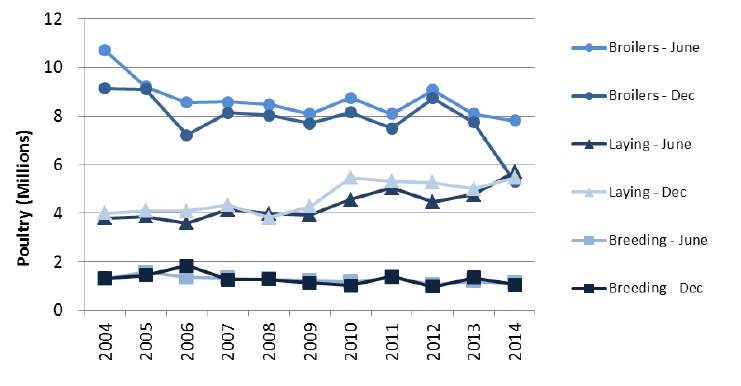



Scottish Poultry Count Down 16 Per Cent in December 2014 Census
SCOTLAND, UK - The results of the latest December Agricultural Survey show that livestock numbers have generally increased over the year although poultry numbers fell sharply.Cattle numbers rose marginally, by 0.4 per cent, to 1.73 million. This was driven by a four per cent increase in dairy cows, with a 1.3 per cent fall in beef cow numbers.
December sheep numbers increased 1.6 per cent to 4.84 million, while pig numbers jumped ten per cent to 322,000.
There was a different picture in poultry though, with 2.4 million fewer broilers leading to a 16 per cent reduction in the overall number of birds.
The area of winter-sown crops in December 2014 was similar to the previous December at 204,000 hectares, with 2,300 hectares more wheat, offset by 1,300 hectares less barley and 500 hectares less oats. Oilseed rape was relatively unchanged.
The results also show that the amount of hay and grass silage saw increases in 2014 but arable silage fell.
There was a 0.6 per cent decrease in the number of tractors, along with falls in various other categories of machinery, which may reflect the increased use of contract working.
Poultry
Comparing the results for the December 2013 and December 2014 surveys, there was a decrease in the total number of poultry of 2.28 million (16 per cent) to 11.91 million - greater than the 3.9 per cent annual decrease reported in the 2014 June Census results, and the lowest December figure of the last 10 years.
There was an increase in birds for laying eggs for eating of 464,719 (9.3 per cent), with the number of layers rising to 5.47 million - though smaller than the 19.5 per cent increase reported in the 2014 June Census results.
A decrease in the number of broilers of 2.45 million (31.6 per cent) to 5.3 million - compared with the 3.5 per cent fall reported in the 2014 June Census results and representing the lowest broiler figures since 2003 (the earliest date for which we have comparable December data for all holdings.
The figure below shows trends over the past 10 years from the December Survey and June Census for broilers (used for meat production), laying fowls (used for egg production) and breeding birds (used to produce broiler and breeder chicks). It should be noted that there is some inherent variability in the annual poultry data, which can be affected by short-term operational factors.
For some years, there have been large differences in the number of broilers and layers between June and December. This variability can occur if large poultry units reduce the number of birds on their holdings over the survey date, for operational reasons such as the cleaning of premises. Also the poultry production cycle is very short compared to other livestock, which provides producers with the flexibility required to change production levels in response to market conditions.

The primary driver in the fall in poultry figures in December 2014 was the fall in broiler numbers. While variability is a feature of poultry figures, the closure of a number of holdings across the country which previously housed large numbers of broilers can explain much of this drop. The fall in the number of broilers follows a drop of 0.98 million in December 2013 and significant restructuring over the period.
The figures for laying birds had been steady at about four million until 2009, before increasing noticeably to a peak of over five million in 2010. Over the 10-year period the December Survey results show an increase of 1.47 million (37 per cent) compared to an increase of 1.92 million (50 per cent) from the June Census.
The trends in the annual number of breeding birds have been fairly constant with the December Survey and June Census both averaging just under 1.3 million birds over the 10-year period.








